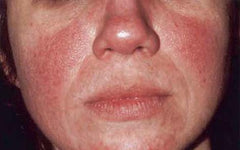Rosacea 101: The Anatomy of Rosacea
Posted on 22 January 2016 by Ning W
Share this post

Rosacea 101: The Anatomy of Rosacea Rosacea – a skin condition that presents itself with reddened cheeks and pus-filled nodules often mistaken for acne – can be embarrassing, but it can also be painful, according to the results of a recent survey. The National Rosacea Society interviewed more than 600 people with rosacea, and found that the majority of them had suffered some discomfort due to the condition, including burning, itching and stinging. “The physical pain experienced by many rosacea patients is often underappreciated by others,” said Dr. John Wolf, chairman of dermatology at Baylor College of Medicine. “Rosacea patients need to take special care to avoid substances that irritate their skin, along with other triggers that might cause irritation and lead to a flare-up.”
What Causes Rosacea?
According to WebMD.com, an estimated 14 million Americans have rosacea, but most of them don’t know it. They – like many others – mistake their condition for acne, and treat it as such. While there are still questions about the direct cause of rosacea, which experts say could be the result of a diminished immune system or nervous system, genetics or bacteria caused by skin mites, essentially, rosacea is the result of veins that don’t work as they should. When our skin is flushed, the blood vessels in our face dilate then close, allowing the flushing to dissipate. For those with rosacea, the blood vessels remain open, causing the skin to remain permanently red. While symptoms are generally mild at the start, as the condition progresses, it becomes progressively worse, and the flushing becomes itching, burning, swollen flesh dotted with visible blood vessels and bumps that resemble pimples. There is no cure for rosacea, and the condition won’t go away, but it can be treated, experts say.
Why Does Rosacea Flare Up?
There are a wide range of things that trigger rosacea flare-ups, according to the National Rosacea Society. Exercise, heat, alcohol use, cold, exposure to sunlight and some foods and beverages can trigger rosacea. Stress is a particularly big trigger, said Bunting, adding that this particular trigger is only exacerbated by the condition and is confidence-zapping effects. “It’s hugely emotive,” Dr. Sam Bunting, a London-based dermatologist, told The Daily Mail. “People can get very self-conscious.” Experts say avoiding triggers can reduce outbreaks, but one person’s normal daily activity is another person’s trigger, which means that for many, rosacea brings life to a screeching halt. “For almost two years rosacea has controlled my life,” said Jen, when asked about her condition by the Rosacea Research Foundation. “I have many triggers for flushing such as bending, sleeping, artificial lighting and stress.” She not only is prevented from getting the mail or going to her children’s schools for programs, she also has trouble sleeping through the night.
Why Does Rosacea Itch?
Rosacea often itches, burns and stings, which are among the worst side effects of the skin condition for those who have it. “Sleeping is one long nightmare,” added Jen. “I cannot lie down, must not let my face touch the pillow, and must stay in the same position all night, so that the flow of cool air from the fan falls directly on my face. Often the burning and pain awakens me. No part of my life is unaffected.” There are several suspects to place the blame for the itching and burning experienced not only by Jen, but also many others with rosacea. Inflammation can cause hair follicles to develop ingrown hairs, leading to a condition known as folliculitis, which is often accompanied by itching. For men whose rosacea itch is associated with folliculitis, letting facial hair grow – following today’s hipster trend – or using a new razor with each shave, can help reduce the condition as well as the itching. Dry skin can also cause itching, especially so during the colder months when heat is on and air is dry. To help replenish skin’s moisture, use a humidifier, keep the logs off your fireplace and lower the temperature setting on your thermostat. Also, check out the label on your skin care products. If you are mistakenly treating your rosacea like acne, you are likely zapping all the essential hydration from your skin, leaving it parched and more prone to itching and burning. “Active inflammation on the face from any cause results in tiny little breaks in the skin,” Dr. Elise Brantley of the University of Cincinnati told Everydayhealth.com. “Because of this breakdown in your natural skin barrier, many things can further irritate the skin, including topical moisturizers with numerous chemicals or fragrances, sunscreens, or even your own natural body sweat.”
Best Rosacea Cream
As we’ve said, because many people have no idea they have rosacea, they treat it with harsh cleansers made to address acne, which can exacerbate symptoms significantly due to tough, chemically-based ingredients that torture already inflamed and irritated skin. Harsh treatments are especially common because they are already in the beauty arsenals of most light-skinned women in their 30s, the group most commonly cursed with rosacea, although people of both sexes and of any age can be impacted. “Women are desperate for their skin to look good so they throw everything at it, but deep cleansing, exfoliating products and masks are all stripping processes that can worsen the condition,” said Bunting. In reality, a gentle, botanical-infused formula that aggressively addresses inflammation is a better choice for rosacea skin care. Rosarid, a product that’s manufactured in the United States and backed by a money-back guarantee, features rich moisturizers to ease the dryness associated with rosacea as well as soothing aloe and cucumber extracts to help target inflammation and reduce swelling. In addition to emollients such as shea butter, almond and avocado oils, mango butter, olive and sunflower oils and vitamin E, Rosarid – available here by Senvie - also includes kiwi and sophora flavescens roots, both of which help restore skin’s natural texture and color. Combined, the ingredients work in synergy to help reduce existing symptoms of rosacea along with future outbreaks.



0 comments